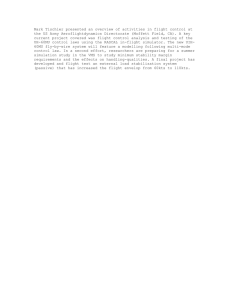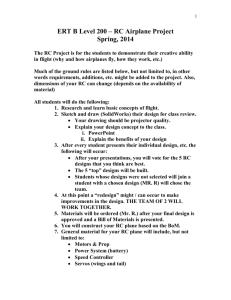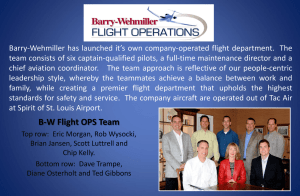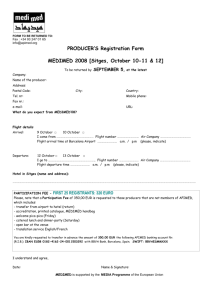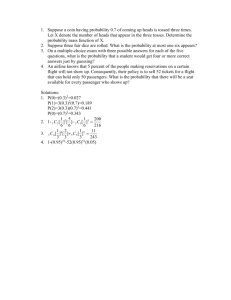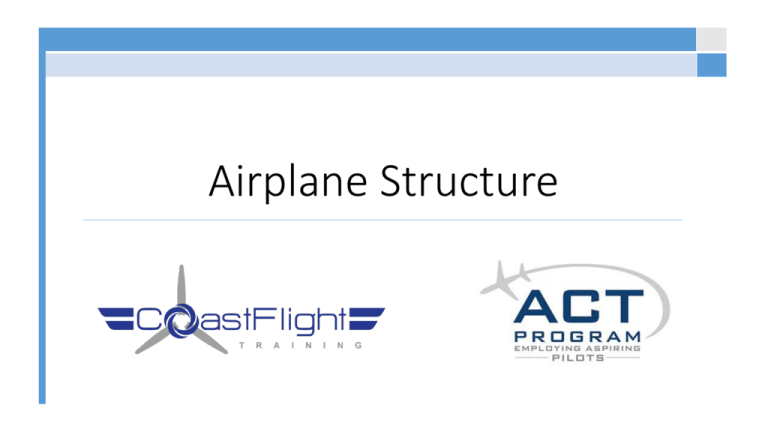
Airplane Structure
The Fuselage
• Open Truss
• Stressed Skin = Semi-Monocoque
• Monocoque – Skin Carries Load
• Composition
• Fabric
• Aluminum
• Composite
© 2015 Coast Flight Training. All Rights Reserved.
Substructure of Semi-Monocoque
• Formers
• Stringers
• Bulkheads
© 2015 Coast Flight Training. All Rights Reserved.
The Wing
• Monoplanes & Biplanes
• Wings made up of Ribs and
Stringers
• Wing Spar
• Skin overlaid on top
• Flaps
• Ailerons
© 2015 Coast Flight Training. All Rights Reserved.
© 2015 Coast Flight Training. All Rights Reserved.
Wing Components
© 2015 Coast Flight Training. All Rights Reserved.
Aspect Ratio
• Wingspan / Mean Chord
• Measure of how long and slender the wing appears from below
• Aerodynamic Efficiency in the High Aspect Ratio Wing
Low Aspect Ratio
Moderate Aspect Ratio
© 2015 Coast Flight Training. All Rights Reserved.
High Aspect Ratio
Constant Chord Wing
• Also known as “Hershey Bar”
or Rectangular Wing
• Found on old Piper Cadets /
Cherokees
• Same distance from leading
edge to trailing edge
throughout
© 2015 Coast Flight Training. All Rights Reserved.
Elliptical Wing
• Almost rounded
• Imagine an oval
© 2015 Coast Flight Training. All Rights Reserved.
Tapered Wing
• Distance tapers from root to tip
© 2015 Coast Flight Training. All Rights Reserved.
Delta Wing
• Triangle
• Think of an Fighter Jets
• (More of a variable sweep wing)
© 2015 Coast Flight Training. All Rights Reserved.
Canard
• “Whiskers”
• Front wing
© 2015 Coast Flight Training. All Rights Reserved.
Sweptback Wing
• Sweeps back throughout shape
• All high altitude aircraft
• 737 or 787
© 2015 Coast Flight Training. All Rights Reserved.
Wing Dihedral
• Design for Stability
• Adds to Lateral Stability (next lesson)
• Gives a shallow V shape
• Will explain more when we talk about aerodynamics
© 2015 Coast Flight Training. All Rights Reserved.
Wing Anhedral
• Design to Reduce Stability
• Opposite of Dihedral
• Will eventually stress as
the wing creates lift
• Will explain more when we
talk about aerodynamics
© 2015 Coast Flight Training. All Rights Reserved.
POH Section 7.1 & 7.3
• Low wing monoplane
• Constructed of Aluminum Alloy (wingtips fiberglass / thermoplastic)
• Four-Place Seating
• Semi-Tapered Wings
• Continuous Main Spar
© 2015 Coast Flight Training. All Rights Reserved.
NACA 652-415 (Highlight and Write)
• 6 Series: Laminar Flow
• 5: Minimum Pressure located 5/10ths of chord aft of leading edge
• 2: Range of low drag is .2 above and below design lift coefficient
• 4: Design lift coefficient
• 15: Maximum thickness = 15% of chord length
© 2015 Coast Flight Training. All Rights Reserved.
Types of Flaps
• Used to slow the airplane down, but create more lift at the same time
• 5 types:
•
•
•
•
•
Plain Flap
Split Flap
Slotted Flap
Fowler Flap
Slotted Fowler
© 2015 Coast Flight Training. All Rights Reserved.
Plain Flap
• Extension of the wing
• Trailing edge of wing moves up and down
• Piper Flaps
© 2015 Coast Flight Training. All Rights Reserved.
Split Flap
• Drops from the Wing
• Underneath the trailing edge
• Does not extend upward
© 2015 Coast Flight Training. All Rights Reserved.
Slotted Flap
• Extension of the wing
• Opens a slot so air can escape
• Cessna has a Slotted-Plain Flap
© 2015 Coast Flight Training. All Rights Reserved.
Fowler Flap
• Drops from the wing and
extends the length of the wing
• Moves aft and outward at the
same time
• Boeing and Airbus style
© 2015 Coast Flight Training. All Rights Reserved.
Archer Flap
• Plain Flap
• Activated by a Johnson bar between seats
• 3 positions:
• 10 degrees
• 25 degrees
• 40 degrees
• Do NOT step when in down position
• Always call “Flaps coming down”
© 2015 Coast Flight Training. All Rights Reserved.
Empenage
• Tail section of the aircraft
• Consists of:
•
•
•
•
•
Horizontal Stabilizer (or stabilator)
Elevator
Vertical Stabilizer
Rudder
Trim Tabs
© 2015 Coast Flight Training. All Rights Reserved.
Vertical Stabilizer
• Acts as a similar to a keel on a
sailboat
• Keeps airplane from constantly
rolling
• Rudder is attached
© 2015 Coast Flight Training. All Rights Reserved.
Horizontal Stabilizer
• Acts as a backwards wing
• Counteracts the movement of Center of Gravity
• Without it – nose down
© 2015 Coast Flight Training. All Rights Reserved.
Elevator
• Used to control pitch
(up and down)
• Newton’s third law
• Opposes force of air
and pushes the
airplane upwards
© 2015 Coast Flight Training. All Rights Reserved.
Stabilator
• Combination of horizontal stabilizer and elevator
• Trims with an anti-servo tab
• Moves as an entire unit
© 2015 Coast Flight Training. All Rights Reserved.
Trim Devices
• Servo
• Helps the pilot move the control surface
• Decreases pilot force, destabilizes aircraft
• Anti-servo – Same Direction
• Resists the pilots inputs to move the control surface
• Increases pilot force, stabilizes aircraft
• Rudder Trim
• Moving a drum between the rudders
© 2015 Coast Flight Training. All Rights Reserved.
Rudder
• Helps coordinate
flight through the
air
• Similar to drifting or
sliding in a car
© 2015 Coast Flight Training. All Rights Reserved.
Landing Gear
• Principle support during park, taxi, takeoff, landing
• Types:
• Wheels
• Conventional (Tailwheel)
• Tricycle (nosewheel) – Steerable!
• Floats
• Skis
© 2015 Coast Flight Training. All Rights Reserved.
© 2015 Coast Flight Training. All Rights Reserved.
© 2015 Coast Flight Training. All Rights Reserved.
Brakes
• Most single-engine tricycle aircraft have steerable nose wheels
• 30 degrees either side of center line (POH 7.7)
• Also differential braking in the main gear
• Hydraulically controlled
• Activate by toe of the pedal
© 2015 Coast Flight Training. All Rights Reserved.
Powerplant
• Engine
•
•
•
•
Primary function to turn propeller
Generates electrical power
Provides vacuum source for some flight instuments
May provide heat in cold temp situation
• Propeller
• General means of thrust
© 2015 Coast Flight Training. All Rights Reserved.
Engine
• Covered by cowling or nacelle
• Helps to cool the engine by ducting air around cylinders
© 2015 Coast Flight Training. All Rights Reserved.
Propellers
• Composition
• Alluminum
• Wood
• Composite
• Fixed Pitch
• Only one blade angle
• Constant Speed
• Choose blade angle
© 2015 Coast Flight Training. All Rights Reserved.
Archer Engine
• 4 cylinder
• Carbureted
• Horizontally opposed
• Air cooled
• Normally aspirated
• Direct drive
• Lycoming O-360
© 2015 Coast Flight Training. All Rights Reserved.
Archer Propeller
• 76 inch
• Seinsenich
• Aluminum Alloy
• 2 bladed
© 2015 Coast Flight Training. All Rights Reserved.
Aircraft Documents
• Airworthiness Certificate – Never expires
• Registration – Every 3 years
• Radio Station License – Issued by FCC (only international)
• Operating Limitations – Also known as the POH or AFM
• Weight and Balance – The official Weight and Balance in the AFM
• Equipment List – Special Aircraft have:
• Minimum Equipment List
• Kinds of Operation Equipment List
© 2015 Coast Flight Training. All Rights Reserved.
Maintenance Requirements
AVIATES
• Airworthiness Directives
• VOR Check
• Inspections to include:
• 100 hour
• Annual
•
•
•
•
Altimeter
Transponder
ELT
Static System
© 2015 Coast Flight Training. All Rights Reserved.
Airworthiness Directives
• 2 types
• One-time
• Recurring
• Routine and Emergency
• Mandatory document from FAA that MUST be complied with
• Similar to a recall notice
• Keep record of compliance
© 2015 Coast Flight Training. All Rights Reserved.
VOR Check
• Must be completed every 30 calendar days
• Only required for IFR
• Private Pilot or greater does this check
© 2015 Coast Flight Training. All Rights Reserved.
Types of VOR Checks
• VOT
• Airborne VOR checkpoint
• Ground VOR checkpoint
• Dual
• We’ll come back to this in XC flying
© 2015 Coast Flight Training. All Rights Reserved.
Inspections – 91.409
• Annual
• Completed by an IA
• Every 12 calendar months
• One log for each component: Airframe, Powerplant and Propeller
• 100 hour
•
•
•
•
Required if aircraft is for hire
Completed by an A&P
Can be overflown by 10 %
Exact same inspection as Annual
© 2015 Coast Flight Training. All Rights Reserved.
Altimeter
• Test to ensure that it reads correctly
• IFR purposes only
• Recommended for VFR
• Completed by a Certified Repair Station
• Completed every 24 calendar months
© 2015 Coast Flight Training. All Rights Reserved.
Transponder
• When Needed:
•
•
•
•
Mode C Veil
Above 10,000 feet (excluding 2,500 AGL)
Lateral boundaries of Bravo
Lateral boundaries of Charlie
• Completed every 24 calendar months
• Completed by a Certified Repair Station
© 2015 Coast Flight Training. All Rights Reserved.
ELT
• Two inspections:
• General Inspection
• Battery Inspection
• Date
• More than 1 cumulative hour
• 50% of useful life
• Inspection normally completed by an IA or A&P
• Completed every 12 calendar months
• Can be tested 5 minutes after the hour
© 2015 Coast Flight Training. All Rights Reserved.
Static System
• Required Inspection only for IFR purposes
• 24 calendar months
• Completed by a Certified Repair Station
© 2015 Coast Flight Training. All Rights Reserved.
Preventive Maintenance
• Completed by a PPL or Greater
• Must be entered in maintenance records
• Limited work, provided it does not involve complex assembly
operation
• See FAR 43 Appendix A Subpart (c)
© 2015 Coast Flight Training. All Rights Reserved.
Return to Service – Maintenance Entry
• Must place in the Maintenance Records:
• Description of work performed
• Date work was completed
• Signature, Certificate Number, Type of Cert
© 2015 Coast Flight Training. All Rights Reserved.
Return to Service – Flight Test
• All aircraft after maintenance must be flown by at least a private pilot
before the carriage of passengers
• Only required after major repair or alteration
© 2015 Coast Flight Training. All Rights Reserved.
After Maintenance
• Always complete a more-thorough pre-flight inspection after any
maintenance has been completed
• A&Ps are people too
© 2015 Coast Flight Training. All Rights Reserved.
In Class Exercise
• Find the Maintenance Entries
© 2015 Coast Flight Training. All Rights Reserved.
References
• FAR part 91
• FAR part 43
• Pilot’s Handbook of Aeronautical Knowledge
• Jeppesen Private Pilot Manual
© 2015 Coast Flight Training. All Rights Reserved.

